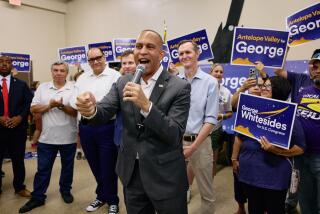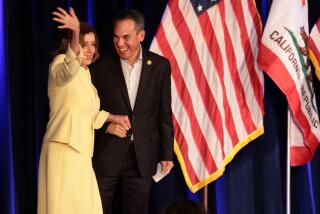Pelosi-Harman friction strains Democrats’ unity
WASHINGTON — When Jane Harman left Congress in 1998 to run for governor of California, her colleague Nancy Pelosi threw her a party -- a chocolate-fudge sundae “social” in the House members’ dining room.
Two years later, Harman hosted a fundraiser in Los Angeles for Pelosi when she was running for minority whip, raising $400,000.
These days the two rarely talk, much less throw parties for each other.
Their relationship has been deteriorating since Harman returned to the House in 2001, according to those who know them, and the tension now threatens to complicate Pelosi’s role as House speaker when the 110th Congress convenes in January.
Pelosi indicated as early as last year that she intended to oust Harman from the Intelligence Committee -- where Harman expected to become chairwoman if Democrats won control of the House -- in favor of someone more to Pelosi’s liking.
The move has created dissension within the party. Some Democrats and foreign policy experts argued that Harman, a centrist on national security, is the most credible person for the job. The Congressional Black and Hispanic caucuses countered that it was time for one of their members on the committee to take the helm.
Fresh from Pelosi’s fierce and unsuccessful lobbying effort to install antiwar ally John P. Murtha of Pennsylvania as her No. 2, the coming battle over the Intelligence Committee leadership is turning into a showdown where the political has turned personal. And it could undermine the unity that the Democratic Party has hoped to show as it prepares to take the reins of power.
The falling-out between Pelosi and Harman offers a window into how business gets done on Capitol Hill, where personal friendships are often as important as policies and politics. Pelosi in particular is noted for remembering who has been on her side and who hasn’t, as evidenced by her support of Murtha for House majority leader over her one-time rival Steny H. Hoyer of Maryland, even though Hoyer was widely preferred by the party caucus.
The prospect of conflict between two such powerful Democratic women is tantalizing to gossipy Washington. But the split is so toxic that Democrats in California and Washington won’t go near it.
“I don’t want to talk about it,” said Roz Wyman, the doyenne of California Democratic fundraising and a friend of both.
Most people contacted for this article spoke only on condition of anonymity, not wanting to get on the wrong side of two formidable politicians.
Pelosi declined through her spokeswoman to comment. The only statement issued from her office, by Press Secretary Jennifer Crider, was that the committee decision “will be made before early January.”
Harman said in an interview that she did not wish to vent the matter in public. “I read about this in the paper last year and I visited with her then,” said Harman, who would not disclose the nature of their conversation.
“It’s so unfortunate because they’re both capable people,” said William Coblentz, a San Francisco lawyer who has contributed to both their careers and coffers. “I know them both well, and I love them both, but I believe Nancy felt that Jane was abrasive and aggressive, which she can be.”
Pelosi’s supporters say the dust-up over Harman is not personal, noting that the Democratic leader spent an extra day in California lobbying the state party to endorse Harman in her reelection bid.
Although they may seem similar on the surface -- two wealthy and powerful Democrats from California -- Pelosi and Harman are cut from different cloth. Pelosi is a people person -- she recently entered a raucous room of reporters offering to shush them in her “mother-of-five voice.” Harman has a more cerebral personality and revels in the minutiae of policy.
Pelosi grew up in Baltimore, where her father, Thomas D’Alesandro Jr., was mayor, and got an early education in the art of machine politics. She met Paul Pelosi while at Trinity College in Washington, and the couple moved to his hometown of San Francisco. As Paul Pelosi grew the family’s fortune through real estate and stock investments, Nancy Pelosi raised their children, then worked her way up in California Democratic Party politics from volunteer to chairwoman for Northern California. She was elected to the U.S. House in 1987.
Harman grew up in Los Angeles, the daughter of a Westside physician. She graduated from Smith College and Harvard Law School at a time when few women went into law. Harman began her career in Washington as a Capitol Hill staffer and later worked in the Carter White House before going into private law practice. She is married to Sidney Harman, founder and chairman of Harman Industries. She ran for the House in 1992 and joined Pelosi in the California delegation, representing Venice.
People who know both women say there was no single incident that soured their relationship; rather it was a series of small irritations that eventually led to estrangement.
Some California Democrats say tensions began during the 2001 redistricting of the state’s congressional seats.
As lawmakers from both parties cooperated in Sacramento to make Democratic seats safer for Democrats and GOP seats safer for Republicans, Harman reportedly complained that her district did not include Los Angeles International Airport.
“She wanted to get the LAX asset in her district,” said one Californian who was familiar with the process. “Jane thinks the airport is power.”
Party leaders were annoyed, given that the redistricting gave Harman -- who until then represented a swing district -- a safe seat.
A Capitol Hill staffer suggested that Pelosi also was miffed that Harman had higher visibility in the media.
Harman, using her platform as ranking Democrat on the Intelligence Committee, landed on Sunday talk shows so regularly that she all but eclipsed Pelosi’s rising star as House minority leader. An informal survey of the major talk shows over the last two years found that Harman made 18 appearances to Pelosi’s six.
Associates of Pelosi say she was not troubled that Harman was on television frequently, only that Democrats’ message on Iraq wasn’t being aired.
Some Democrats say Pelosi’s choice for intelligence chair is less about personal conflict than fixing a political problem, which ironically began with Harman’s return to the House in 2001.
After Harman lost her gubernatorial bid, Pelosi urged her to run for Congress again. Harman’s choice was made easier by the fact that then-Minority Leader Dick Gephardt (D-Mo.) had promised her in writing that she could reclaim her seniority on the Intelligence Committee. That bumped a member of the Congressional Black Caucus, Rep. Sanford D. Bishop Jr. (D-Ga.), off the committee and jumped her over another African American, Rep. Alcee L. Hastings (D-Fla.), in seniority.
Black members of Congress were upset by what they saw as a slap by House Democratic leaders. Last year the black caucus asked for a meeting, and according to one witness, Pelosi promised not to slight either blacks or Latinos when plum slots came up on the Intelligence and Homeland Security committees.
When news got out that Pelosi was not planning to name Harman chairwoman, heavy hitters from the foreign policy establishment besieged Pelosi to change her mind.
Those close to Harman say the lobbying campaign came to life on its own. The Pelosi side doesn’t buy it.
“The biggest mistake Jane made was lining up people to lobby,” said a Hill staffer. “People went over the line lobbying for her. Now Nancy is very angry.”
Asked whether Pelosi held a grudge against Harman, Rep. Anna G. Eshoo (D-Atherton) said: “People are going to do what they’re going to do. But anyone who underestimates Nancy Pelosi does so at her own risk.”
*
michael.finnegan@latimes.com
Neuman reported from Washington and Finnegan from Los Angeles.
*
(BEGIN TEXT OF INFOBOX)
Jane Harman
1945: Born in New York City; raised in Los Angeles where father is a Westside physician
1966: Graduates from Smith College, Northampton, Mass.
1969: Graduates from Harvard Law School; later serves in Carter White House and as Defense Department special counsel
1992-98: Elected by California’s 36th Congressional district
1998: Runs for governor, spending more than $20 million, including $15 million of her own money, but finishes third among Democrats
2000-present: Reclaims her former House seat; joins Energy and Commerce Committee; joins Intelligence Committee, becoming ranking Democrat of new Terrorism and Homeland Security subcommittee
2003: After November 2002 election, chosen by Nancy Pelosi as her successor on Intelligence
2004: Works closely with new Intelligence chairman Peter Hoekstra and Senate Governmental Affairs Chairman Susan Collins to get Congress to pass intelligence reorganization bill
2005: Calls for a ban on torture by U.S. interrogators and a prohibition on transferring detainees to countries that torture
Sources: Almanac of American Politics 2006; office of Jane Harman; Los Angeles Times
**
Nancy Pelosi
1940: Born Nancy D’Alesandro in Baltimore; her father served five terms in Congress ending in 1947, then 12 years as Baltimore mayor
1962: Graduates from Trinity College (now called Trinity University), Washington, D.C.
1977-1981: Northern chair, California Democratic Party
1981-1983: State chair, California Democratic Party
1985-1987: Finance chair, Democratic Senatorial Campaign Committee
1987-present: Elected by California’s 8th Congressional District, which includes most of San Francisco; serves for 10 years (until early 2003) on the Intelligence Committee
2001: Elected minority whip by House Democrats
Oct. 2002: Leads Democratic faction opposed to authorizing military force in Iraq, bucking the House Democratic leader
Nov. 2002: Elected minority leader by House Democrats
Nov. 2006: Slated to become next House speaker after midterm election gains
Sources: Almanac of American Politics 2006; office of Nancy Pelosi; Los Angeles Times
More to Read
Get the L.A. Times Politics newsletter
Deeply reported insights into legislation, politics and policy from Sacramento, Washington and beyond. In your inbox three times per week.
You may occasionally receive promotional content from the Los Angeles Times.











